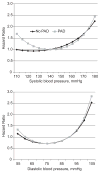Outcomes Among hypertensive patients with concomitant peripheral and coronary artery disease: findings from the INternational VErapamil-SR/Trandolapril STudy
- PMID: 19996066
- PMCID: PMC3000120
- DOI: 10.1161/HYPERTENSIONAHA.109.142240
Outcomes Among hypertensive patients with concomitant peripheral and coronary artery disease: findings from the INternational VErapamil-SR/Trandolapril STudy
Abstract
Hypertension is a common risk factor for peripheral arterial disease (PAD). Guidelines suggest treating PAD patients to a blood pressure <130/80 mm Hg; therefore, our objective was to explore whether attainment of this target blood pressure is associated with improved outcomes. We performed a post hoc analysis of the INternational VErapamil-SR/Trandolapril STudy, a randomized clinical trial, which included hypertensive patients with concomitant PAD and coronary artery disease. There were 2699 PAD patients followed for a mean of 2.7 years (60 970 patient-years). The primary outcome, all-cause death, nonfatal myocardial infarction, or nonfatal stroke, occurred in 16.3% of PAD patients versus 9.2% without PAD (adjusted hazard ratio: 1.26 [95% CI: 1.13 to 1.40]; P<0.0001). The primary outcome occurred least frequently among PAD patients treated to an average systolic blood pressure of 135 to 145 mm Hg and an average diastolic blood pressure of 60 to 90 mm Hg. PAD patients displayed a J-shape relationship with systolic blood pressure and the primary outcome, although individuals without PAD did not. PAD patients may require a different target blood pressure than those without PAD.
Figures




Comment in
-
INVESTing in hypertension.Curr Hypertens Rep. 2010 Apr;12(2):53-5. doi: 10.1007/s11906-010-0101-y. Curr Hypertens Rep. 2010. PMID: 20424956 No abstract available.
Similar articles
-
A calcium antagonist vs a non-calcium antagonist hypertension treatment strategy for patients with coronary artery disease. The International Verapamil-Trandolapril Study (INVEST): a randomized controlled trial.JAMA. 2003 Dec 3;290(21):2805-16. doi: 10.1001/jama.290.21.2805. JAMA. 2003. PMID: 14657064 Clinical Trial.
-
Risk and Blood Pressure Control Rates Across the Spectrum of Coronary Artery Disease in Hypertensive Women: An Analysis from The INternational VErapamil SR-Trandolapril STudy (INVEST).J Womens Health (Larchmt). 2020 Feb;29(2):158-166. doi: 10.1089/jwh.2018.7235. Epub 2019 Aug 12. J Womens Health (Larchmt). 2020. PMID: 31403360
-
Dual therapy in hypertensive patients with coronary artery disease: the role of calcium channel blockers and beta-blockers.Am J Cardiovasc Drugs. 2007;7 Suppl 1:25-9. doi: 10.2165/00129784-200707001-00004. Am J Cardiovasc Drugs. 2007. PMID: 19845074 Clinical Trial.
-
Management of hypertension in peripheral arterial disease: does the choice of drugs matter?Eur J Vasc Endovasc Surg. 2008 Jun;35(6):701-8. doi: 10.1016/j.ejvs.2008.01.007. Epub 2008 Apr 2. Eur J Vasc Endovasc Surg. 2008. PMID: 18375152 Review.
-
The use of secondary medical prevention after primary vascular reconstruction: studies on usage and effectiveness.Dan Med J. 2012 Sep;59(9):B4514. Dan Med J. 2012. PMID: 22951205 Review.
Cited by
-
Mortality implications of angina and blood pressure in hypertensive patients with coronary artery disease: New data from extended follow-up of the International Verapamil/Trandolapril Study (INVEST).Clin Cardiol. 2013 Aug;36(8):442-7. doi: 10.1002/clc.22145. Epub 2013 May 29. Clin Cardiol. 2013. PMID: 23720247 Free PMC article. Clinical Trial.
-
2018 Korean society of hypertension guidelines for the management of hypertension: part III-hypertension in special situations.Clin Hypertens. 2019 Aug 1;25:19. doi: 10.1186/s40885-019-0123-y. eCollection 2019. Clin Hypertens. 2019. PMID: 31388452 Free PMC article.
-
Effect of blood pressure lowering medications on leg ischemia in peripheral artery disease patients: A meta-analysis of randomised controlled trials.PLoS One. 2017 Jun 2;12(6):e0178713. doi: 10.1371/journal.pone.0178713. eCollection 2017. PLoS One. 2017. PMID: 28575088 Free PMC article.
-
Interaction and combined effect of triglyceride-glucose index and hypertension on type 2 diabetes individuals' peripheral arterial disease risk.Acta Diabetol. 2025 May;62(5):717-729. doi: 10.1007/s00592-024-02391-1. Epub 2024 Oct 26. Acta Diabetol. 2025. PMID: 39460758
-
Characteristics and long-term follow-up of participants with peripheral arterial disease during ALLHAT.J Gen Intern Med. 2014 Nov;29(11):1475-83. doi: 10.1007/s11606-014-2947-1. J Gen Intern Med. 2014. PMID: 25002161 Free PMC article. Clinical Trial.
References
-
- Hirsch AT, Halverson SL, Treat-Jacobson D, Hotvedt PS, Lunzer MM, Krook S, Rajala S, Hunninghake DB. The Minnesota Regional Peripheral Arterial Disease Screening Program: toward a definition of community standards of care. Vasc Med. 2001;6:87–96. - PubMed
-
- Criqui MH, Langer RD, Fronek A, Feigelson HS, Klauber MR, McCann TJ, Browner D. Mortality over a period of 10 years in patients with peripheral arterial disease. N Engl J Med. 1992;326:381–386. - PubMed
-
- Newman AB, Sutton-Tyrrell K, Vogt MT, Kuller LH. Morbidity and mortality in hypertensive adults with a low ankle/arm blood pressure index. JAMA. 1993;270:487–489. - PubMed
-
- Steg PG, Bhatt DL, Wilson PW, D’Agostino R, Sr, Ohman EM, Rother J, Liau CS, Hirsch AT, Mas JL, Ikeda Y, Pencina MJ, Goto S. One-year cardiovascular event rates in outpatients with atherothrombosis. JAMA. 2007;297:1197–1206. - PubMed
Publication types
MeSH terms
Substances
Grants and funding
LinkOut - more resources
Full Text Sources
Medical
Research Materials

